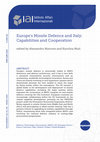Papers by Christian Mölling

Rome, IAI, April 2021, 116 p. (Documenti IAI ; 21|05), 2021
Europe's missile defence is structurally linked to NATO deterrence and defence architecture, and ... more Europe's missile defence is structurally linked to NATO deterrence and defence architecture, and it has to face both a worsened international security environment and an accelerating, worldwide technological innovation. Russia and China are heavily investing in new hypersonic systems which dramatically decrease the time needed to reach the target by flying mostly within the atmosphere. The US remains a global leader in the development and deployment of missile defence capabilities, including the Aegis systems which represent the cornerstone of NATO integrate air and missile defence covering the Old Continent. European countries are increasingly collaborating within the EU framework on the related capability development, primarily via the TWISTER project under the Permanent Structured Cooperation (PeSCo). Being exposed to missile threats from Middle East and North Africa and participating to allied nuclear sharing, Italy has a primary interest in upgrading its military capabilities through PeSCo, maintaining them fully integrated within NATO, and involving the national defence industry in cutting-edge procurement programmes.

Uploads
Papers by Christian Mölling